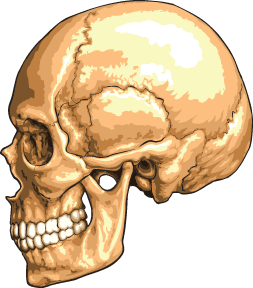MRI is currently the gold standard for identifying radicular pathology, but unfortunately, it requires preauthorization, which isn’t easy to obtain. Physical tests are what most practitioners depend on – despite the marginal reliability of the tests. The information in this article brings history and observation to the forefront of radicular diagnostics. Each factor listed can significantly increase the clinician’s ability to diagnose radiculopathies.
The Sphenoid, Acupuncture and Healing
Without question one of the most significant, albeit overlooked functions of the human system is the vital role of the sphenoid bone in neurological and hormonal health issues. This butterfly-shaped bone, which makes up the floor of the skull, articulates with literally all of the bones of the skull, making it a central pivot point of the entire cranium. It comprises the majority of the posterior wall of the optic compartment. Its anatomical structure is extremely complex and difficult to understand, forcing the famed physician Sir Oliver Wendell Holmes to utter at the opening of an anatomy lecture at Harvard Medical School, "Gentlemen, damn the sphenoid bone." If you have studied the anatomy of the sphenoid, you undoubtedly share this sentiment.
The sphenoid bone's two most notable structures are the cup-like "sella turcica" (Turkish saddle) at the floor of the skull, which houses and protects the pituitary gland (master gland of the endocrine system); and the sphenobasilar articulation of the occipital bone. The sphenobasilar joint is where the sphenoid articulates with the occipital bone and because of its amphiarthroidial (partially movable synchondrosis) nature, establishes what many consider to be one of the most significant articulations of the body. This is due to the milking effect this joint has upon cerebrospinal fluid, in addition to its overall effect on the pituitary gland and the general nervous system.

Because of the limited degree of flexibility within the sphenobasilar articulation, which it carries throughout life, this joint may and does become stagnated as a result of either major or minor head trauma to any surface of the skull, altered biomagnetic energetic effects of the Lower Shao Yang (Gallbladder) meridian, eye strain or muscle spasm along the occipital / cervico area to include any malocclusion of the teeth and TMJ involvement.
Stagnated qi or energetic disruption in addition to fixation subluxation of the sphenobasilar joint may produce a variety of conditions that may persist if the vital areas affecting the sphenoid bone are not addressed. Most notably are dysfunctions of the endocrine system including the thyroid, adrenal, parathyroid, ovaries, testicles and all glands of the body.
The pituitary gland, being the master gland of the body, directly affects all of the endocrine system; any dysfunction involving sense of taste, smell, speech or hearing, tremors, tics, choreic movements, tinnitus, deafness, depression, migraine, any type of headache, especially those emanating from the occiput, frontal or around the eyes, insomnia, temperature regulation disturbance, eye ptosis, any vision issue, nasal involvement, memory disturbance, inability to concentrate (focus), and hyperactivity behavior.
Children are especially prone to injury of the occiput and sphenoid because of increased frequency of falls and bumps, as are adults involved in sports and accidents. Any bump to the cranium, especially the frontal, temporal and occiput, may be responsible for a variety of nonresponsive health conditions.
Acupoints That Influence Sphenoid Function
Three specific acupoints have the most impact on the sphenoid and its relationship to neurological functioning: Tai Yang, Yin Tang and GV16. Tai Yang is the famed acupoint located just behind the zygomatic arch, lateral to the eye socket and halfway between the end of the eyebrow and the outer canthus of the eye. The point specifically lies over the great wing of the sphenoid at the side of the head bordered by the frontal, parietal, zygoma and temporal bones, and has major neurological connections throughout the body. In my opinion, this point is one of the most powerful points on the body.
Yin Tang, another famed acupoint, is located at the glabella directly between the eyebrows. The glabella is located where the frontal bone and maxilla articulate, both of which have connections with the sphenoid. This point has been used for a variety of conditions in acupuncture; however, when it is combined with Tai Yang it has a profound effect on sphenoid-related dysfunction.
GV16 (DU16) is located just under the occiput below the inion or occipital "bump." This point is noted for its neurological effects. Because of posterior inferior malposition of the occiput, a key approach in treating this point is to use percussive therapy in addition to general needle, electronic or laser stimulation, either by hand or preferably with a percussive instrument, in a superior direction; or by direct digital pressure with firm tapping.
This procedure produces absolutely fantastic clinical response. If you are not exactly sure of the approach, simply begin utilizing Tai Yang, Yin Tang, and GV16 with a non-invasive teishein for 25 strokes in short bursts of five on your difficult and non-responsive patients and watch what happens. These points are to be used bilaterally on Tai Yang, as both Yin Tang and GV16 are midline points. Add GV14, KI27, and the occiput, frontal vertex and brain stem points of the ear.
Editor's note: I would love to hear about your clinical successes utilizing these or other acupoints for sphenoid-related or other dysfunctions. Also, if you would like a graphic of the points mentioned in this article, e-mail me at dramaro@iama.edu with "Acupoints of the Sphenoid" in the subject field.


